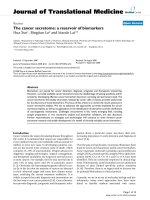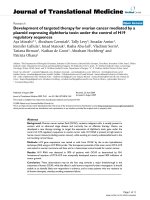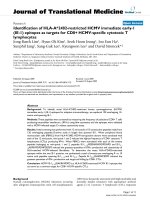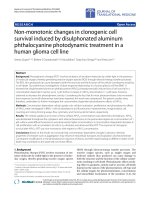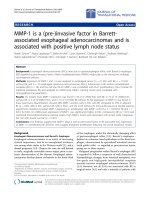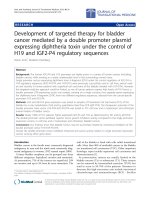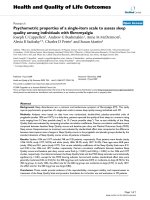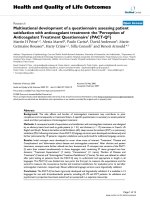báo cáo hóa học: " Error mapping controller: a closed loop neuroprosthesis controlled by artificial neural networks" doc
Bạn đang xem bản rút gọn của tài liệu. Xem và tải ngay bản đầy đủ của tài liệu tại đây (981.2 KB, 13 trang )
BioMed Central
Page 1 of 13
(page number not for citation purposes)
Journal of NeuroEngineering and
Rehabilitation
Open Access
Methodology
Error mapping controller: a closed loop neuroprosthesis controlled
by artificial neural networks
Alessandra Pedrocchi*, Simona Ferrante, Elena De Momi and
Giancarlo Ferrigno
Address: Nitlab, Bioengineering Department, Politecnico di Milano, Milano, Italy
Email: Alessandra Pedrocchi* - ; Simona Ferrante - ; Elena De
Momi - ; Giancarlo Ferrigno -
* Corresponding author
Abstract
Background: The design of an optimal neuroprostheses controller and its clinical use presents
several challenges. First, the physiological system is characterized by highly inter-subjects varying
properties and also by non stationary behaviour with time, due to conditioning level and fatigue.
Secondly, the easiness to use in routine clinical practice requires experienced operators.
Therefore, feedback controllers, avoiding long setting procedures, are required.
Methods: The error mapping controller (EMC) here proposed uses artificial neural networks
(ANNs) both for the design of an inverse model and of a feedback controller. A neuromuscular
model is used to validate the performance of the controllers in simulations. The EMC performance
is compared to a Proportional Integral Derivative (PID) included in an anti wind-up scheme (called
PIDAW) and to a controller with an ANN as inverse model and a PID in the feedback loop
(NEUROPID). In addition tests on the EMC robustness in response to variations of the Plant
parameters and to mechanical disturbances are carried out.
Results: The EMC shows improvements with respect to the other controllers in tracking
accuracy, capability to prolong exercise managing fatigue, robustness to parameter variations and
resistance to mechanical disturbances.
Conclusion: Different from the other controllers, the EMC is capable of balancing between
tracking accuracy and mapping of fatigue during the exercise. In this way, it avoids overstressing
muscles and allows a considerable prolongation of the movement. The collection of the training
sets does not require any particular experimental setting and can be introduced in routine clinical
practice.
Background
Nowadays neuromuscular electrical stimulation allows
simple clinical practice of rehabilitation therapy, even if
some of its initial promises have failed. Indeed, the com-
plex motor control performed by the Central Nervous Sys-
tem (CNS) is hard to reproduce by any artificial
controller, even to recover a single function like gait, sit to
stand or grasping.
Published: 09 October 2006
Journal of NeuroEngineering and Rehabilitation 2006, 3:25 doi:10.1186/1743-0003-3-25
Received: 28 March 2006
Accepted: 09 October 2006
This article is available from: />© 2006 Pedrocchi et al; licensee BioMed Central Ltd.
This is an Open Access article distributed under the terms of the Creative Commons Attribution License ( />),
which permits unrestricted use, distribution, and reproduction in any medium, provided the original work is properly cited.
Journal of NeuroEngineering and Rehabilitation 2006, 3:25 />Page 2 of 13
(page number not for citation purposes)
Several studies were presented in the last years aiming at
controlling such motor tasks by stimulation [1-4] and
some commercial products are available in the market [5-
8]. Functional stimulation allows conditioning muscular
tone, reducing joint stiffness, increasing peripheral vascu-
larisation, preventing ulcers and providing a good cardi-
orespiratory training. In addition functional
neuromuscular stimulation provides the CNS with a com-
plete afference of the motor function to be re-learnt offer-
ing promising advantages in the rehabilitation of
incomplete spinal cord injured, stroke and ataxia patients
[9,10].
In this frame, the development of sophisticated control
systems is a crucial point in the design of neuroprostheses.
Namely, the control should be able to let the limb track
accurately the desired movement and to repeat the exer-
cise as long as possible, even if fatigue occurs. The prob-
lem of fatigue is actually particularly amplified for
artificial contraction because muscular fibres are activated
synchronously, at higher frequency and in the opposite
order with respect to the natural contraction.
A neuroprosthesis should be specifically calibrated on a
single subject and even on a single session of each subject.
The design has to face the well-known difficulties of con-
trolling the human neuromuscular apparatus: non linear,
time varying, redundant and very difficult to model ana-
lytically. In addition to these typical bioengineering prob-
lems, there is another crucial aspect in the design of a
neuroprosthesis, i.e., making it easy to use in clinics. The
real widespread use in clinical practice as well as the prob-
ability of being accepted by many patients strongly
depend on short preparation and on exercise procedures
being easy.
Most controllers available for functional neuroprostheses
in clinical practice are feedforward (FF) [11-13]. They pre-
defined a fixed stimulation pattern during the motor task.
By definition, a FF controller did not include any correc-
tion on the basis of the current performance, limiting the
possibility to track the time variability of the neuromuscu-
lar apparatus. On the contrary, several feedback (FB) con-
trollers were proposed. Adaptive controllers [14] and PID
controllers were designed for the purpose [15]: Veltink
showed that the good tracking performance of PID con-
trollers was offset by a considerable time lag between ref-
erence and actual joint angle, which became more marked
when exercises were protracted in time. In order to reduce
the time lag and to give the PID a FF guess, model-based
controllers were combined with PID [1]. These included a
neuro-musculo-skeletal model of the system to be con-
trolled. Unfortunately, the large quantity of parameters
required for the identification of the system to be control-
led was difficult to be experimentally determined and,
anyway, a long preparation for each patient was needed in
each session. An attempt to reduce this problem was the
replacement of the physiological model with a non-linear
black-box model, such as an artificial neural network
(ANNs). Chang et al. [16] proposed a NEUROPID con-
troller composed by a neural network trained to behave as
inverse model in the FF line and a fixed-parameter PID
feedback controller, thereby making adjustments for
residual errors, due to external disturbances, or to errone-
ous model identification. Results demonstrated an
improvement of tracking performance with respect to
Veltink [15], especially because of the reduction of the
PID time lag. However, such controller still required long
preparation for the PID setting and when fatigue
increased, the controller was overstressing the stimulation
inducing itself a very fast fatigue increase.
Abbas et al. [17-19] proposed a control system which used
a combination of adaptive FF and FB control techniques.
The FF adaptive controller was a pattern generator/pattern
shaper (PG/PS), in which PG generated a stable oscilla-
tory rhythm while PS (a single-layer neural network) took
its input from PG and provided the muscles with stimula-
tion. A fixed-parameter proportional-derivative (PD) FB
controller enhanced disturbance resistance and supple-
mented the action of the FF controller. This controller
showed a good performance both in simulation and in
experimental sessions, with a good capability of control-
ling different subjects. The adaptive controller was dem-
onstrated only to repeat one-pattern sequences. However,
no particular evidences were reported by the authors
about the efficacy of the controller in tracking fatigue.
Even if it could be used with many patterns, this could
strongly decrease the efficiency and velocity of the adap-
tive controller, being the architecture of PS multiplied by
the number of patterns. In the study proposed by Jezernik
et al. [20], a sliding mode controller was developed and
demonstrated a good stability and robustness to parame-
ter variations in an early stage of the movement, before
the occurrence of fatigue. As discussed by the authors
themselves, one of the main drawbacks of the controller is
the time required for the tuning phase of the great number
of parameters.
In a previous study developed by our research group [21],
an adaptive control system (NEURADAPT) based on
ANNs was designed to control the knee joint angle in
accordance with desired trajectories, by stimulating quad-
riceps muscles. This strategy included an inverse neural
model of the stimulated limb in the FF line and a ANN
trained on-line to learn a PID behaviour in the feedback
loop. Despite the encouraging results, the ANN in the
feedback loop still relied on a PID: it needed the PID
parameters identification phase and it also produced a
considerable time lag between the reference and actual
Journal of NeuroEngineering and Rehabilitation 2006, 3:25 />Page 3 of 13
(page number not for citation purposes)
joint angle, due to the intrinsic delay of the integrative
part of the PID function.
With the presented literature and these previous results as
a starting point, the control strategy developed and pre-
sented in this study is totally free of a PID controller.
In order to combine the engineering requirements along
with the clinical specifications, we designed a control sys-
tem for a neuroprosthesis, called Error Mapping Control-
ler (EMC), for a simple motor task such as knee flexion
and extension. This neuroprosthesis was completely
designed to identify the controller in the normal steps of
clinical use of electrical stimulation, avoiding extra com-
plex protocol procedures to the therapist and the patient.
Methods
EMC structure is reported in Figure 1. It included a FF
ANN inverse model (ANNIM) of the system to be control-
led and a neural network trained to compensate the
fatigue effects in the FB loop, Neuro Feedback (NF).
ANNIM stored a stable scheme of the motor apparatus
and it was able to convert the planned desired movement
(trajectory) into motor commands (pulse width of the
stimuli). FB controller (NF) provided the correction of the
motor command depending on the current error of the
executed movement and on the estimation of the current
fatigue level.
Neuro-muscular skeletal model
In order to simulate neuromuscular skeletal features of
the lower limb of a paraplegic subject, a biomechanical
model, adapted from Riener and Fuhr [4], was imple-
mented in Matlab Simulink
®
(MathWorks, Inc. Massachu-
setts). The Plant was constrained to move in the sagittal
plane and the knee was assumed to be an ideal hinge
joint. The movement considered was the flexion exten-
sion of the knee. Inputs to the Plant were the pulse width
of the stimuli delivered to the quadriceps through surface
electrodes. The Plant output was the knee joint angle. Five
muscle groups were considered: hamstrings (i.e. semi-
membranosus, semitendinosus, biceps femoris long
head), bicep femoris short head, rectus femoris, vasti mus-
cles, lateral and medial gastrocnemius.
Muscle groups could be treated independently and were
characterized by activation and contraction parameters.
Muscular activation included the effect of spatial summa-
tion (through the recruitment curve), the effect of tempo-
ral summation (through the calcium dynamics) and the
muscular fatigue. When the quadriceps were stimulated
with a pulse width greater than the recruitment threshold
(100 μs), other muscles still contributed to limb dynamics
by their passive viscous and elastic properties. The
dynamic modellization took the elastic and the viscous
torque into account (for more details see [4]).
EMC controllerFigure 1
EMC controller. EMC structure.
Journal of NeuroEngineering and Rehabilitation 2006, 3:25 />Page 4 of 13
(page number not for citation purposes)
To describe the effect of fatigue/recovery, a fitness func-
tion fit(t) was used [4]. It can be expressed by the follow-
ing first order relation:
where a(t) was the activation of the not fatigued muscle
and fit
min
was the minimum fitness parameter. The time
constants for fatigue (T
fat
) and for recovery (T
rec
), as well
as fit
min
, were estimated from stimulation experiments [4].
The term λ(f) was introduced by Riener and Fuhr [4] to
better account for the fact that muscle fatigue rate strongly
depends on stimulation frequency and it was expressed by
the following relation:
In our stimulations the stimulation frequency f was
always fixed at 40 Hz and β was a shape factor not
dependent on frequency or muscles.
Finally, the activation of the tiring muscle was given by:
a
fat
(t) = a(t)* fit(t) (eq. 3)
The fatigue occurrence showed a decrease of the muscle
input gain to 50% of its nominal value over 100 s, com-
parable to [17].
Artificial Neural Network Inverse Model
Following direct-inverse modelling approach [22], the
pulse width waveforms, used as ANNIM desired outputs,
were rectified sinusoids and triangles of different duration
and amplitude. The ANNIM inputs were obtained stimu-
lating the nominal Plant, i.e., not including the fatigue
effects (fit(t) = 1), in response to the chosen pulse width
signals. In order to take the system dynamics into account,
ANNIM inputs were augmented with signals correspond-
ing to past inputs. Therefore, ANNIM inputs were the
actual knee angle and velocity and their 4 previous sam-
ples (q(t), q(t-1), , q(t-4)) and ( (t), (t - 1), , (t -
4)). It has already been established that adding noise to
the training data in artificial neural learning improves the
quality of learning, as measured by the trained networks
ability to maximize exploration of the input/output space,
avoid overfitting and generalise [23]. Therefore, a white
noise was added to the input signals (mean 0, standard
deviation equal to 5% of the maximum pulse width
value). Several networks were trained and the smallest
network architecture that gave good RMSE and similar
performance between training and testing data was cho-
sen, as reported in details in a previous article of the
authors [21]. The ANNIM was a multilayer FF perceptron
with 10 input neurons, 10 neurons in hidden layer and 1
neuron in the output layer. We chose the hyperbolic tan-
gent as the activation function of the hidden layer and the
logarithmic sigmoid function in the output layer, map-
ping the non linearity of the Plant and the bounded stim-
ulation range. The Levenberg-Marquardt learning
algorithm was used to train ANNIM [24].
Neuro feedback
NF training set was obtained using a setup including the
series of ANNIM, Plant and another ANNIM (Figure 2).
This scheme was aimed at obtaining the relationship
between the angular error and the pulse width signal dur-
ing a repeated movement sequence, where the effect of
muscular fatigue, as well as any time variant occurrence,
was evident. Desired angle (q
des
) was input to the ANNIM,
that had already been trained, producing the correspond-
ing desired pulse width (PW
des
) as an output. PW
des
was
then given as an input to the Plant, where fatigue was
modelled. Output of the Plant was the actual angle (q
act
),
i.e., the angle generated stimulating a Plant in which the
fatigue effect was included. After that, q
act
was used as an
input to the second ANNIM, which was exactly a copy of
the first one, converting it in the PW domain producing
PW
act
. PW
act
was the nominal pulse width corresponding
to the actual movement q
act
. Therefore, the angular error
Δq = q
act
- q
des
was correlated to an estimation of the current
fatigue level expressed in the pulse width domain: ΔPW =
PW
act
- PW
des
.
These two signals were used as input/output couples for
NF training set. Thus NF was trained to produce ΔPW as
an output, when it received as an input the correspondent
angular error Δq. This training set allowed NF to work as
a predictor and a compensator of the fatigue effect: when
the Plant was getting tired, the angular error (Δq)
increased and NF gave an extra pulse width (ΔPW). Once
trained NF allowed estimating the fatigue level and map-
ping the actual angular error into a needed correction in
the pulse width domain.
The signal used to build the training set of NF (q
des
in Fig-
ure 2) was a repeated sequence of consecutive flexion
extension trajectories lasting 100 s. The training set
included 12 angular trajectories lasting 100 s, having dif-
ferent profiles, durations and amplitudes; some examples
of the first angular oscillation are reported in Figure 3.
The NF was a non-adaptive multilayered perceptron with
10 input neurons, 8 neurons in the hidden layer and 1 in
dfit t
dt
fit fit t a t f
T
fit t a t f
fat
()
=
−
()
()
() ( )
+
−
()
()
−
() ( )
min
λλ
11
(()
()
T
rec
eq .1
λββ
f
f
f
()
=− +
⎛
⎝
⎜
⎞
⎠
⎟
<
()
1
100
100 2
2
for Hz eq .
q
q
q
Journal of NeuroEngineering and Rehabilitation 2006, 3:25 />Page 5 of 13
(page number not for citation purposes)
the output layer. We chose the hyperbolic tangent as the
activation function in order to allow positive and negative
corrections of pulse width. The introduction of past inputs
allowed the network to map the dynamic nature of the
system. The training algorithm was Levenberg-Marquardt
[24].
Capability to resist to mechanical disturbances
More than the tracking performance and the capability to
manage fatigue occurrence, the EMC controller proved its
resistance to internal disturbances that could occur during
the stimulation. Such disturbances could be caused by
internal spastic muscle contractions or external loading of
the limb. In order to model a mechanical disturbance
such as a spasm, a square wave lasting for two seconds was
delivered to the simulator with the limb in different posi-
tions during the simulated movement. The spasm ampli-
tude ranged between 20% and 30% of the maximal total
torque of the knee: the spasm model was analogous to
[17].
An additional test on the effect of a distributed noise on
the knee torque was designed to check the capability of
the controller to face random variations in the Plant. This
test could simulate an error in the stimulation or in the
electrodes coupling with the skin. Random noises uni-
formly distributed between ± 25%, ± 30%, ± 35%, ± 40%,
± 45% and ± 50% of the maximal knee torque were tested,
as in Abbas et al. [17].
EMC robustness
EMC capabilities to track time varying physical parame-
ters, indicating an increase or a decrease of the fitness level
of the subject, were tested as a second aspect of this meth-
odological study. In particular, the robustness of our con-
troller was tested changing the following parameters: the
damping property of the leg, the time constant of fatigue
and recovery and the weight of the limb. The values of
these coefficients were fixed "a priori" in the model. For
this reason, the training of the ANNs of EMC was not
including any variation of such parameters. Anyway,
ANNs generalization capability could partly adapt to
these possible variations.
All these parameters were changed up to ± 50% of their
nominal value and the angular RMSE on the 1
st
(not
fatigued) and the 5
th
(fatigued) flexion extension of a
repetitive trial were assessed.
Reference controllers anti wind-up PID (PIDAW) and
NEUROPID
In order to prove advantages of EMC strategy, a compari-
son with two reference controllers was performed: a tradi-
tional closed loop controller PID and the model-based
neural controller, NEUROPID, proposed by Chang [16].
The PID controller general form in the time domain is
given by:
NF Training schemeFigure 2
NF Training scheme. Scheme used to collect the training set of NF.
Journal of NeuroEngineering and Rehabilitation 2006, 3:25 />Page 6 of 13
(page number not for citation purposes)
where: e(t) is the difference between the reference and the
actual value of the controlled variable, and Kp, Ki, Kd, are
the proportional, integrative and derivative parameters
respectively.
The PID controller parameters were first identified using
an iterative procedure based on the minimization of Root
Mean Square Error (RMSE) [25], where the initial estima-
tion of the optimization was derived from the Ziegler-
Nichols rules [26]. Then the transfer function of the PID
was discretized in view of a digital implementation of the
control algorithm.
A saturation block was added between the output of the
PID controller and the stimulator input in order to limit
the pulse width values between 0 and 500 μs. The use of
integral action in the PID controller combined with actu-
ator saturation can give undesirable effects: if the error sig-
nal is so large that the integrator saturates the actuator, the
feedback path will be broken because the actuator would
remain saturated even if the Plant output changed. The
integrator, being an unstable system, may then integrate
up to large values. When the error is finally reduced, the
integration may be so large that it will take much time
before the output of the integrator falls to a normal value.
This effect is called integrator wind-up. To avoid it, a PID
was introduced in an anti wind-up scheme [27], in the fol-
lowing PIDAW.
The NEUROPID controller, developed by Chang at al.
[16], included an ANN in the FF loop, which was the
inverse model of the system, and a PID in the feedback
loop, which was able to adjust the pulse width signal in
case of error between the desired and the actual angle.
In order to compare the three listed controllers (PIDAW,
NEUROPID, EMC), we simulated controlled repeating
sequences of flexion extension movements lasting 100 s
and we computed the RMSE between actual and desired
angular values.
A non parametric Kruskal-Wallis test (p < 0.05) was car-
ried out to highlight significant differences between the
RMSE obtained by the three controllers at different levels
of fatigue. A Dunn-Sidak post hoc test was performed to
understand which pairs of effects were significantly differ-
ent.
ut K t K e d K
de t
dt
Pi d
t
() () ( )
()
=+ +
∫
ττ
0
Examples of the NF training signalsFigure 3
Examples of the NF training signals. Some examples of the first 10 seconds of the signals used to build the NF training set
are reported in this figure. Each trajectory was delivered for 100 s to the setup reported in Figure 2 in order to obtain the Δq
and ΔPW signals.
Journal of NeuroEngineering and Rehabilitation 2006, 3:25 />Page 7 of 13
(page number not for citation purposes)
Results
Tracking performance
In Figure 4 the tracking performance of the three control-
lers (EMC, PIDAW and NEUROPID) is shown in the case
of no fatigue.
Without fatigue, the tracking capability of EMC was very
similar to the NEUROPID one, while the PIDAW showed
the typical time lag. The RMSE between the desired and
actual trajectory shown in Figure 4 was about 1,7° for
EMC, 7,7° for the PIDAW and 3.2° for NEUROPID.
Fatigue mapping
In order to test fatigue mapping capabilities, the compar-
ison of the three controllers was performed in terms of the
RMSE obtained in response to simulations of 100 s using
6 different angular trajectories (repeated oscillations of
different amplitudes, from 40 to 70 degrees and each
oscillation lasted from 2 to 10 seconds). In Figure 5 an
example of the performance of the three controllers with
fatigue is reported. In this case, the three controllers
behaved very differently: PIDAW and NEUROPID
increased the stimulation pulse width rapidly, due to the
increasing tracking error. Within the third cycle, the pulse
width raised up to the limit (500 μs) and in the next rep-
etition it remained saturated for more time. Unfortu-
nately, due to fatigue, such stimulation did not achieve
the correct tracking of the desired path and it was greatly
tiring out the Plant. In addition, in between two successive
cycles, those two controllers were not suspending the
stimulation but they only reduced it. The continuous
stimulation did not permit the possibility of recovery. In
contrast, the EMC was always able to keep the stimulation
at lower levels. In this way, the fatigue was increasing
more slowly and the exercise was repeated with more
amplitude for much longer. The EMC avoided over-stim-
ulating the Plant in reaching the desired trajectory when
fatigue was too strong and it always had an interval of no
stimulation in between waves, which was fundamental
for recovery. In this way, it was able to prolong the exer-
cise with satisfying extensions.
The three controllers were tested in response to different
testing signals lasting 100 s not included in the training set
of both the ANNs of the EMC. Between 90 and 100 s the
mean value of the RMSE with respect to the desired knee
EMC vs traditional controllers without fatigueFigure 4
EMC vs traditional controllers without fatigue. A comparison of the performance obtained by the three controllers in
term of angular trajectories and pulse width without considering the muscular fatigue effect.
Journal of NeuroEngineering and Rehabilitation 2006, 3:25 />Page 8 of 13
(page number not for citation purposes)
angle trajectories tested was about 14° for the EMC, while
it was about 21° for the PIDAW and 23° for the
NEUROPID.
The results of the Kruskal Wallis test is reported in Figure
6 and highlighted that there were significant statistical dif-
ferences between the RMSE obtained by the three control-
lers in three different periods of time (0–30 s, 30–60 s,
60–90 s). The Dunn-Sidak post hoc test showed that a sig-
nificant difference was present between all the controllers
in all the time periods.
Resistance to disturbances
In order to test resistance to internal mechanical distur-
bances (like occurring spasms), the comparison of the
three controllers was performed in terms of the RMSE dur-
ing flexion extension movements lasting 100 s. Six spasms
occurrences, each lasting 2 s, were randomly added to the
Plant knee torque during the 100 s simulation, both dur-
ing the extension and flexion. For each spasm, different
amplitudes were tested (between 20% and 30% of the
maximal total torque of the knee). Performances of the
three controllers are reported in Figure 7. The increase of
the RMSE due to the spasms, evidenced by the lines cross-
ing each column in Figure 7, was very similar for the three
controllers in the early spasms as well as in the later ones,
independently from the phase of the cycle. These results
demonstrated that even if the EMC was never trained to
respond to such disturbances both the stability of the sys-
tem and its capability to generalize to unknown events
was comparable to the other two reference controllers,
keeping anyway the specific advantages on fatigue estima-
tion.
In order to test resistance to random noises of different
amplitudes (ranging from 25% to 50% of the knee
torque), the comparison of the three controllers was per-
formed in terms of the RMSE during flexion extension
EMC vs traditional controllers with fatigueFigure 5
EMC vs traditional controllers with fatigue. An example of the comparison of the performance obtained by the three
controllers in terms of angular trajectories and pulse width. The testing signal lasted 100 s and during the trial fatigue was
strongly affecting the Plant performance.
Journal of NeuroEngineering and Rehabilitation 2006, 3:25 />Page 9 of 13
(page number not for citation purposes)
movements lasting 100 s. A random noise was added to
the whole sequence. The EMC had the best performance
reducing evidently fatigue effect and tracking discrepancy,
both in the initial oscillations (without fatigue) and for
the last oscillations (9–10
th
) when fatigue is strongly
affecting the Plant performances (Figure 8).
Robustness
EMC robustness with respect to changes in the Plant
parameters was tested by calculating the error in tracking
performance and the results are shown in Figure 9. The
circles represent the error on the first flexion extension
(wave1), while asterisks represent the values of the RMSE
on the fifth flexion extension, i.e., after about 50 s of stim-
ulation (wave 5).
Modifications in the viscoelastic properties, i.e., damping
value, of the Plant were compensated very well by the
EMC, damping changes of 50% affected the results less
than 1° both in the first and in the fifth leg movement.
Analogously, the EMC coped with the changes in the time
required for recovery from fatigue, (T
rec
), well. As expected
a slight increase of the RMSE was obtained when T
rec
was
increased. Naturally, the first wave was not affected much
by the variation of this parameter, like the variation in T
fat
,
because fatigue was not yet present at this stage of the
movement. The effect of variations of T
fat
was much more
evident, when negative variations of T
fat
were simulated
(meaning a faster occurrence of fatigue) and in fact the
RMSE increases exponentially in the left part of the panel
referred to as T
fat
in Figure 9. On the contrary, positive var-
iations of T
fat
reduced the error. Indeed, the EMC was
trained to face fatigue up to the defined value of T
fat
;
higher values of T
fat
indicated a slower fatiguing, well
addressed by the EMC. Lower values of T
fat
, on the con-
trary, were not in anyway included in the training set. The
robustness of the controller when lower leg mass was sim-
ulated, was good in the case of a reduction of the mass. In
this case, while an overshooting was shown at the first
cycle, once the error was detected by the feedback, NF cor-
rection reduced the error (asterisks lower than circles). On
the contrary, in case of an increase of the mass of the leg,
the effect was very similar to when fatigue occurred faster,
showing a quick increase of the error. However, positive
variations of 20% led to error of less than 10°.
Discussion
The EMC showed good tracking performance when
fatigue phenomenon was not present or stayed at low lev-
els. In those cases, the EMC was more accurate with
respect to the other two controllers tested, especially in
avoiding the PID time lag. Similar levels of angular errors
Statistical comparison of EMC vs traditional controllersFigure 6
Statistical comparison of EMC vs traditional controllers. Comparison of the performance obtained by EMC, PIDAW
and NEUROPID in terms of the median and the quartiles of the RMSE obtained on 6 different testing angular trajectories. Such
comparison was divided in three periods (0–30 s, 30–60 s and 60–90 s). The Kruskal-Wallis test highlighted significant differ-
ences between the controllers. The asterisks indicate that the Dunn-Sidak post-hoc test showed a significant difference
between the RMSE.
Journal of NeuroEngineering and Rehabilitation 2006, 3:25 />Page 10 of 13
(page number not for citation purposes)
were showed by other controllers proposed in literature,
like the Sliding Mode Controller [20]. Namely, the EMC
tracking error on the same trajectories used by Jezernik
was about 4.5°, which is quite comparable to the best
result reported by those authors (about 3°).
However, the most significant advantage of the EMC was
visible when fatigue was great. The behaviour of the EMC
during the process of tiring was completely different to the
other two controllers, PIDAW and NEUROPID, reducing
the RMSE by a third after 100 s.
The EMC achieved such different performance because
the NF correction considered tracking of the desired trajec-
tory as well as the level of fatigue. The training solution of
the EMC translated the angular error into pulse width cor-
rection estimating the differences between the actual
fatigued performance with respect to the nominal one. In
this way, the EMC corrected the stimulation parameters
by giving an extra pulse width correlated to the level of
fatigue. The main effect of this strategy was that stimula-
tion parameters grew much more slowly during repeated
flexion extensions, thereby not saturating and not over-
stressing the stimulated muscle. This behaviour was
exactly contrary to PID based controllers [1,15,16,21].
The latter stimulated the muscle to a maximum, depend-
ing only on the angular error and not evaluating the feasi-
bility of tracking. This solution, once fatigue was too
strong to permit proper tracking, caused an over-stimula-
tion of the muscle, inducing an even more rapid fatigue
ramp. Analogously, the PG/PS controller proposed by
Reiss and Abbas [19] had the same philosophy of the PID,
being the adaptive controller tuned by a PD controller on
the angular error only. Anyway, not a complete test on
fatigue managing was available for the PG/PS controller,
being fatigue included in the muscle model only in the
simulations discussed in [17], where the testing trajectory
was very small in amplitude (25°), lasted just 10 s, with a
stimulation frequency of 20 Hz. Such testing trajectory is
completely different from those used in EMC training and
testing and, anyway, is not adequate to verify the capabil-
ity of coping the fatigue occurrence as specifically aimed
in the EMC design.
In addition, the EMC was able to resist well to mechanical
disturbances, even if such occurrences were not included
in the examples used for training. This property was simi-
lar to PID based controller, thereby maintaining the
advantage of the best fatigue mapping learnt by the EMC.
Robustness in the model parameters was tested and the
satisfactory results obtained ensured good generalization
Capability to react to spasmsFigure 7
Capability to react to spasms. Comparison of the three controllers (EMC, PIDAW and NEUROPID) performed in terms
of the RMSE during flexion extension lasting 100 s. X axis represents the events indicating spasms occurrence during the move-
ment. 6 spasms were randomly added to the 100 s angular trajectories. Each spasm lasted 2 s and its amplitude was varied from
20% and 30% of the maximal total torque of the knee.
Journal of NeuroEngineering and Rehabilitation 2006, 3:25 />Page 11 of 13
(page number not for citation purposes)
for successive sessions on the same subject, especially in
the case of a good muscle conditioning. It has to be men-
tioned that offline, after each single session, depending on
the observed errors, an extra training of NF could be per-
formed if necessary.
To verify the stability of the EMC controller for step and
ramp knee movements, analogously to Jezernik et al. [20]
and the EMC remained always stable. Instability was
never observed in all the experiments carried out in this
study.
EMC training on the preparation of the exercise is a crucial
point in the clinical applicability of the controller. Actu-
ally, in order to train the inverse model (ANNIM) the sub-
ject needs to be stimulated with a variety of pulse width
shapes and the corresponding knee angle are recorded.
The set of pulse width/angle forms the training set of the
ANNIM when the task is done in nominal conditions (no
fatigue) or in initial single movements with long rest
phases in between. Once such network is trained, the sub-
ject is stimulated longer, inducing fatigue, in a following
session. A set of trajectory errors will be used as training
input of the NF neural network and the corresponding
desired output will be built using the replication of the
ANNIM (Figure 2). These ANN training sets could be col-
lected during the conditioning period, when patients usu-
ally become familiar with electrical stimulation and
increase muscular tone. In such a way, a conditioning
period, which normally takes place before the controlled
stimulation session, is exploited for controller training. By
the way these collection procedures do not globally
change the programme for patients and do not require
any specific setup except the one which will be used for
the functional neuroprosthesis, simplifying therapists'
efforts. This aspect is one important advantage with
respect to other controllers discussed in literature, such all
those based on PID [17-19,25,26] as well as model based
controllers [25] and sliding mode controllers [20].
The last point concerns the possibility to generalize the
EMC control strategy to more complex motor tasks. In
these experiments, we utilized a cyclic joint angle tracking
task to evaluate the performance of the control system.
This task, which has been used in the evaluation of several
neuroprosthesis control systems in the past [1,15-21,25]
may represent a simplified version of practical actions that
could be performed with FES systems, such as: FES exer-
cise systems that utilize cyclic movements and lower-
extremity FES systems for generating patterned move-
ments such as gait, side-stepping, and stair-climbing.
More importantly, however, the task used in these experi-
ments demonstrates the ability of the controller to auto-
matically account for the subject-specific musculo-skeletal
input/output properties, and for fatigue occurrence that
would be exhibited in many FES tasks.
Supporting a good translational property of EMC over
multiple muscles and more complex tasks two points
should be considered: first, EMC do not use any extra
setup to identify the parameters of the controller. Second,
neural networks can process many inputs and have many
outputs; they are readily applicable to multivariable sys-
tems.
Conclusion
We proposed a controller, called EMC, for neuromuscular
stimulation of knee flexion extension which is composed
by a feedforward inverse model and a feedback controller,
both implemented using neural networks. The training of
the networks is conceived to avoid to a therapist and a
patient any extra experiment, being the collection of the
training set included in the normal conditioning exercises.
The EMC philosophy differs from classical feedback con-
trollers because it does not merely react to the error in the
tracking of the desired trajectory, but it estimates also the
actual level of fatigue of the muscles. This solution allows
to prolong the exercise improving the conditioning
effects. In addition, the controller robustness was tested,
demonstrating a good capability of generalizing and thus
reducing the time consuming for re-training, especially if
subjects conditions are improving.
Capability to react to distributed noiseFigure 8
Capability to react to distributed noise. Comparison of
the three controllers performed in terms of the RMSE during
flexion extension sequence of 10 oscillations for a total dura-
tion of 100 s. Random noises of different amplitudes were
added on the knee torque (ranging from 25% to 50% of the
maximum knee torque values). The RMSE was evaluated sep-
arately for each oscillation of the angular trajectory (X axis),
hence at different levels of fatigue.
Journal of NeuroEngineering and Rehabilitation 2006, 3:25 />Page 12 of 13
(page number not for citation purposes)
Competing interests
The author(s) declare that they have no competing inter-
ests.
Authors' contributions
AP and SF have made substantial contributions to concep-
tion and design, acquisition of data, analysis and interpre-
tation of data and manuscript drafting; EDM have made
part of acquisition of data, analysis and interpretation of
data and have been involved in drafting the manuscript;
and GF have made substantial contributions to concep-
tion and design and interpretation of data and have given
final approval of the version to be published.
Acknowledgements
The authors wish to thank Marco Iannò and the students who collaborated
to part of the activities.
References
1. Ferrarin M, Palazzo F, Riener R, Quintern J: Model-based control
of FES-induced single joint movements. IEEE Trans Neural Syst
Rehabil Eng 2001, 9(3):245-257.
2. Chen J, Yu N, Huang D: Applying fuzzy logic to control cycling
movement induced by functional electrical stimulation. IEEE
Trans on Rehab Eng 1997, 5(2):158-169.
3. Hunt K, Stone B, Negard N: Control strategies for integration
of electric motor assist and functional electrical stimulation
in paraplegic cycling: utility for exercise testing and mobile
cycling. IEEE Trans Neur Sys Rehab Eng 2004, 12(1):89-101.
4. Riener R, Fuhr T: Patient-driven control of fes-supported
standing-up: a simulation study. IEEE Trans Rehab Eng 1998,
6:113-124.
5. Wieler M, Stein RB, Ladouceur M, Whittaker M, Smith AW: Multi-
center evaluation of electrical stimulation systems for walk-
ing. Arch Phys Med Rehabil 1999, 80:495-500.
6. Haugland M, Larsen B, Burridge JH, Svaneborg N, Iversen H: A pre-
liminary non-randomised study to evaluate the safety and
performance of the acti-gait implanted drop-foot stimulator
in established hemiplegia. Proceedings of 9th Annual Conf Int FES
Soc: 6–9 September 2004; Bournemouth UK 2004:153-55.
7. Smith B, Peckham P, Keith M, Roscoe D: An externally powered,
multichannel, implantable stimulator for versatile control of
paralyzed muscle. IEEE Trans Biomech 1987, 34(7):499-508.
8. Ijzerman M, Stoffers T, In 't Groen F, et al.: The ness handmaster
orthosis: restoration of hand function in c5 and stroke
patients by means of electrical stimulation. J Rehabil Sci 1996,
9:86-89.
9. Vitenzon AS, Mironov EM, Petrushanskaya KA: Functional elec-
trostimulation of muscles as a method for restoring motor
functions. Neurosci Behav Physiol 2005, 35(7):709-14.
10. Stein RB, Chong SL, James KB, Kido A, Bell GJ, Tubman LA, Bélanger
M: Electrical stimulation for therapy and mobility after spinal
cord injury. Prog Brain Res
2002, 137:27-34.
11. Lan N, Crago PE, Chizeck HI: Control of end-point forces of a
multijoint limb by functional electrical stimulation. IEEE Trans
Biomed Eng 1991, 38:953-965.
12. Marsolais EB, Kobetic R: Functional electrical stimulation for
walking in paraplegia. J Bone Joint Surg 1987, 69-A(5):728-733.
13. Peckham PH, Keith MW: Motor prostheses for restoration of
upper extremity function. In Neural Prostheses: Replacing Motor
Function After Disuse or Disability Edited by: Stein RB, Peckham PH, Pop-
ovic D. London, UK: Oxford Univ. Press; 1992:162-190.
EMC robustnessFigure 9
EMC robustness. EMC generalization performance obtained changing 4 parameters: damping, T
rec
, T
fat
and the limb mass.
The horizontal axis indicates the percent by which the parameter has been varied, the vertical axis indicates the RMSE error.
The errors in the first oscillation (wave 1, reported in circles) and in the fifth (wave 5 reported in asterisks) of a repetitive
angular trajectory are shown.
Publish with Bio Med Central and every
scientist can read your work free of charge
"BioMed Central will be the most significant development for
disseminating the results of biomedical research in our lifetime."
Sir Paul Nurse, Cancer Research UK
Your research papers will be:
available free of charge to the entire biomedical community
peer reviewed and published immediately upon acceptance
cited in PubMed and archived on PubMed Central
yours — you keep the copyright
Submit your manuscript here:
/>BioMedcentral
Journal of NeuroEngineering and Rehabilitation 2006, 3:25 />Page 13 of 13
(page number not for citation purposes)
14. Hatwell MS, Oderkerk BJ, Sacher CA, Inhar GF: The development
of a model reference adaptive controller to control the knee
joint of paraplegics. IEEE Trans on Automatic Control 1991,
36:683-691.
15. Veltink P: Control of fes-induced cyclical movements of the
lower leg. Med Biol Eng Comput 1991, 29:8-12.
16. Chang G, Luh J, Liao G: A neuro-control system for the knee
joint position control with quadriceps stimulation. IEEE Trans
Rehabil Eng 1997, 5:2-11.
17. Abbas J, Chizack H: Neural network control of functional neu-
romuscular stimulation systems: Computer simulation stud-
ies. IEEE Trans Biomed Eng 1995, 42(11):1117-1127.
18. Riess J, Abbas J: Adaptive neural network control of cyclic
movements using functional neuromuscular stimulation.
IEEE Trans Rehab Eng 2000, 8(1):42-52.
19. Riess J, Abbas J: Adaptive control of cyclic movements as mus-
cles fatigue using functional neuromuscular stimulation. IEEE
Trans on Neural Syst and Rehab Eng 2001, 9(3):326-330.
20. Jezernik S, Wassink RGV, Keller T: Sliding Mode Closed-Loop
Control of FES: Controlling the Shank Movement. IEEE Trans
on Biomed Eng 2004, 51(2):263-272.
21. Ferrante S, Pedrocchi A, Iannò M, De Momi E, Ferrarin M, Ferrigno
G: Functional electrical stimulation controlled by artificial
neural networks: pilot experiments with simple movements
are promising for rehabilitation applications. Funct Neurol
2004, 19(4):243-252.
22. Kumpaty S, Narendra K, Parthasarathy K: Identification and con-
trol of dynamical systems using neural networks. IEEE Trans
Neural Networks 1990, 1:4-27.
23. Matsuoka K: Noise injection into inputs in back-propagation
learning. IEEE Transactions on Systems, Man and Cybernetics 1992,
22(3):436-440.
24. Hagan M, Menhaj M: Training feedforward networks with the
Marquardt algorithm. IEEE Trans Neural Networks 1994,
5(6):989-993.
25. Quintern J, Riener R, Rupprecht S: Comparison of simulation and
experiments of different closed-loop strategies for functional
electrical stimulation: experiments in paraplegics. Artif Organs
1997, 21:232-235.
26. Ferrarin M, D'Acquisto E, Mingrino A, Pedotti A: PID controller for
knee movement restoration with closed-loop fes system.
Proceedings of the 18th Annual International Conference of the IEEE Engi-
neering in Medicine and Biology Society: 31 October–3 November 1996;
Amsterdam, The Netherlands 1996:453-454.
27. Ferrante S, Previdi F, Ferrigno G: Model identification for fes sup-
ported standing up and sitting down. Proceedings of 9th Annual
Conf Int FES Soc: 6–9 September 2004; Bournemouth UK 2004:210-212.
